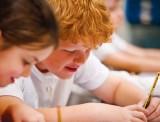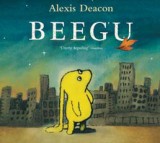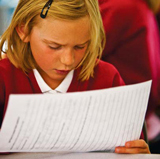Carol Satterthwaite looks at how children can gain a deeper understanding of texts...
When I was eleven I used to be able to complete a comprehension ‘question and answer’ text-card in record time; and then do other children’s, in return for them doing my maths cards! I don’t think this meant that I was a brilliant at comprehension, I had just learnt the pattern of how to do it quickly. There is absolutely nothing wrong with helping children learn how to answer these types of questions - in fact it’s an essential skill for passing tests, but there is so much more to learning how to comprehend a text.
• Be clear about the comprehension skills you are teaching
• Provide opportunities for high quality dialogue
• Spend time teaching new vocabulary explicitly – it’s worth it!
 Start with the skill. This instantly makes it easier to select the right teaching strategy and activity. Successful comprehension of a text is a highly complex process but you can teach the associated skills in a straightforward, systematic and interactive way. The comprehension skills listed to the right are based on research by Pressley et al (2000) and can provide an invaluable list when assessing, planning and teaching.
Start with the skill. This instantly makes it easier to select the right teaching strategy and activity. Successful comprehension of a text is a highly complex process but you can teach the associated skills in a straightforward, systematic and interactive way. The comprehension skills listed to the right are based on research by Pressley et al (2000) and can provide an invaluable list when assessing, planning and teaching.
But what does this look like in practice? Here are some simple thoughts and ideas based on Beegu by Alexis Deacon: a beautiful story for young children about a small creature who crash lands on Earth from another planet. Alone and confused, Beegu tries to get help from the big and small beings she meets. Unfortunately the big creatures don’t seem to want to help her at all – it is the small ones who welcome her into their world.
There is of course a happy ending. The themes of the story provide plenty of opportunities for offering personal responses, empathising with the character, visualisation and summarising the main ideas, but the activities over the page show the types of teaching strategies that could be used to develop all of thecomprehension skills identified. Beegu’s speech bubbles at the start and end of the book, which are pictographs rather than words, could provide excellent opportunities for visualisation, sequencing and invention of dialogue in particular.
It’s a good idea to build up a bank of strategies for each comprehension skill and add to the list each time you use a different book. Choose your text carefully, thinking about whether it creates a rich enough ‘world’ to be explored, with enough depth of issues and choices to be made by the characters.
 In-depth understanding of a text requires time and ‘cognitive space’ – both of which are usually very hard to come by in a busy classroom! Pacey lesson warm-ups are fabulous for developing and prac tising certain skills, but are often not so effective for helping children deepen and extend their responses to texts. Try allowing a 30 minute time slot with a clear, skill based objective such as ‘to learn how to ask questions of a text’ or ‘to learn how to give re asons for our ideas’. Give yourself space and time to think and try not to ‘over- direct’ the discussion in the first instance or offer too much feedback.
In-depth understanding of a text requires time and ‘cognitive space’ – both of which are usually very hard to come by in a busy classroom! Pacey lesson warm-ups are fabulous for developing and prac tising certain skills, but are often not so effective for helping children deepen and extend their responses to texts. Try allowing a 30 minute time slot with a clear, skill based objective such as ‘to learn how to ask questions of a text’ or ‘to learn how to give re asons for our ideas’. Give yourself space and time to think and try not to ‘over- direct’ the discussion in the first instance or offer too much feedback.
Read the text (or ask the children to), show images, allow some silence for thinking time and then ask facilitative questions such as the ones suggested by Aidan Chambers in his ‘Tell Me’ approach, e.g.‘Tell us what you think’ or ‘What thoughts, ideas / feelings came into your mind when you heard / saw this?’ Allow everyone a chance to say what they think, don’t give too much feedback (you could say ’ That’s an interesting idea / point / thought’) and listen extremely carefully in order to build on what the children are saying. At a later stage you can ask more directquestions and help them to extend their thinking and responses together.
 One of the key inhibitors to comprehending a text is our inability to understand the individual words. It’s often the technical vocabulary in any instruction manual, for example, that makes me want to throw the remote at the newly purchased item. Poor vocabulary knowledge has been identified as the prime cause of academic failure in disadvantaged children. This fact in itself is a good enough reason for timetabling a daily slot for playing language games to help children to develop and use new vocabulary. Act out, provide props and images and talkabout new words when reading a text. Make time to ‘herald’ new words before you start to read, always asking the children first if there are any words they don’t understand. Introduce – and use constantly – vocabulary at a much higher level than the children are using in their own conversations. After a week of using the word ‘dilapidated’ in every possible context in Reception, children will not only understand what it means but will start to use it in their writing.
One of the key inhibitors to comprehending a text is our inability to understand the individual words. It’s often the technical vocabulary in any instruction manual, for example, that makes me want to throw the remote at the newly purchased item. Poor vocabulary knowledge has been identified as the prime cause of academic failure in disadvantaged children. This fact in itself is a good enough reason for timetabling a daily slot for playing language games to help children to develop and use new vocabulary. Act out, provide props and images and talkabout new words when reading a text. Make time to ‘herald’ new words before you start to read, always asking the children first if there are any words they don’t understand. Introduce – and use constantly – vocabulary at a much higher level than the children are using in their own conversations. After a week of using the word ‘dilapidated’ in every possible context in Reception, children will not only understand what it means but will start to use it in their writing.
Comprehension is not just for SATs papers, it’s for life – enjoy teaching it!

Comprehension activities for Beegu (and other texts)...
• Pick out images from the book and ask children to think of three questions about each image. Children should keep a record of their questions and return to them later. For example, the opening pages of Beegu picture a star filled sky at night and this would be excellent for speculating about who, where or what might happen in the story.
• Orally tell the story using the pictograph in Beegu’s speech bubble at the end of the book. Change the story slightly and then re-tell it. (See Pie Corbett’s Talk for Writing for more information on Storytelling and Storymaking.)
• In small world play, use figures / pictures to re-tell and invent new adventures.
• Make up a description of Beegu’s planet, read it aloud and ask the children to draw it. Check the drawings against your own.
• Record key ideas onto a spider diagram – what is the story telling us / what have we found out? Ask children to write down three things they know about aliens / humans.
• Beegu wants to explain to her friends back on her planet what she has found out about Earth. Can children talk-draw-write-share and create Beegu’s ‘What I found out’ mini-book?
• Children talk-draw-write-talk to create a book of ideas about what their perfect place might be like.
• Challenge children with predicaments and problems. What would they do if Beegu asked for their help (mime / talk / draw)?
• What if the opposite had happened? How might we tell / draw / write the story?
• Play a true / false game. Is it true or false that Beegu was lonely? How do we know? Create a 1+1=2 grid, e.g. Beegu talked to the rabbits + Beegu talked to the tree = They didn’t understand her.
• Provide a discussion board where children can independently write their responses – yes / no / I think so because - to a statement from the book.
 • Draw a square on a sheet of A4, divide it into four and label each section with one of the following headings: likes, dislikes, puzzles, patterns. (These can be laminated and handed out to every child.) Read the text or show the illustrations to the class and ask them what they like or dislike about it. Do they have any questions or does anything puzzle them? Are there ideas they find interesting or similar to other texts they have read? Children can either draw or write down their responses onto the grid and then talk in pairs, groups, or as a class to develop and share their ideas. The front cover of Beegu is a good place to start.
• Draw a square on a sheet of A4, divide it into four and label each section with one of the following headings: likes, dislikes, puzzles, patterns. (These can be laminated and handed out to every child.) Read the text or show the illustrations to the class and ask them what they like or dislike about it. Do they have any questions or does anything puzzle them? Are there ideas they find interesting or similar to other texts they have read? Children can either draw or write down their responses onto the grid and then talk in pairs, groups, or as a class to develop and share their ideas. The front cover of Beegu is a good place to start.
• Ask children to complete a prediction grid: Where might Beegu have come from? Etc.
• Use flashbacks and role-play what might have happened an hour before the story begins (a spaceship crash).
• Explore ‘What ifs?’, perhaps using freeze frames; for example, ‘What if the big ones had been helpful?’
• Hot-seat the teacher in role as Beegu. Create freeze frames epicting scenarios from the book, e.g. when Beegu is taken away then later reunited with her parents. Mime a part of the story when Beegu is feeling happy/lonely.
• Create word storms, perhaps imagining where Beegu comes from, or how she feels when she thinks her mother is calling her.
• Explore words such as ‘perfect’ and ‘hopeful’. What is ‘perfect’? When are the children ‘hopeful’?

• activate prior knowledge predict
• ask and answer questions of the text
• construct mental images (visualisation)
• sequence the text mentally
• make deductions and inferences
• summarise
• empathise
• give a personal response
• understand vocabulary and grammatical structures
Carol Satterthwaite is a former Senior Literacy Consultant for the Primary National Strategy. She designs and leads literacy projects with networks of schools and for local authorities. carolsatterthwaite.com
How to use Harry Potter to engage high-ability learners
Ace-Languages
Use coaching to turn failures into learning success
Ace-Classroom-Support
Outstanding schools: RJ Mitchell Primary
Outstanding schools
